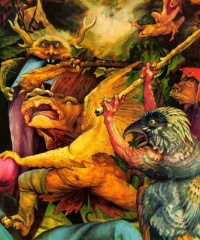Isenheim Altarpiece
From The Art and Popular Culture Encyclopedia

Saint Anthony Tormented by Demons: This panel depicts Saint Anthony being tormented by monstrous creatures sent by Satan. Trampled to the ground, beaten with sticks, torn by claws and bitten, Saint Anthony appeals to God for help who sends angels to combat these evil demons. In the lower left corner, the being with webbed feet and a distended belly seems to personify the disease caused by ergot poisoning, resulting in swelling and ulcerous growths.
|
Related e |
|
Featured: |
The Isenheim Altarpiece is an altarpiece painted by the German artist Matthias Grünewald between 1512 and 1516. It is on display at the Unterlinden Museum at Colmar, Alsace, now in France.
By far his greatest, as well as his largest work, it was painted for the Monastery of St. Anthony in Isenheim near Colmar (then in Germany), which specialized in hospital work. The Antonine monks of the monastery were noted for their treatment of sufferers of skin disease, such as ergotism, symptoms of which are displayed by figures including the crucified Christ in the altarpiece.
Composition
The altarpiece has two sets of wings, displaying three configurations. The first view shows a Crucifixion scene, flanked by images of Saint Anthony and Saint Sebastian. There is a predella with an Entombment of Christ, which remains in the second view also. When the outermost wings are opened, the second view shows scenes of the Annunciation, the original subject of Mary bathing Jesus to the accompaniment of an Angelic choir (or various other titles), and the Resurrection. The innermost view shows the Temptation of Saint Anthony and the Meeting of Saint Anthony and the Hermit Paul to the sides, and a pre-existing carved gilt-wood altarpiece by Nicolas Hagenau of about 1490. Now the altarpiece has been dis-assembled (and sawn through) so that all the views can be seen separately, except that the original sculpted altarpiece is no longer flanked by the panels of the third view, which are instead shown together. Carved wood elements at the top and bottom of the composition were lost in the French Revolution, when the whole painting was nearly destroyed.
Iconography
The iconography of the altarpiece has several unusual elements, several dervived from closely following the acoounts left by Saint Bridget of Sweden of her mystical visions. These had long had a significant influence on art, especially on depictions of the Nativity of Christ, a scene not included here. The crucifixion includes Saint John the Baptist, long dead by Gospel chronology.

